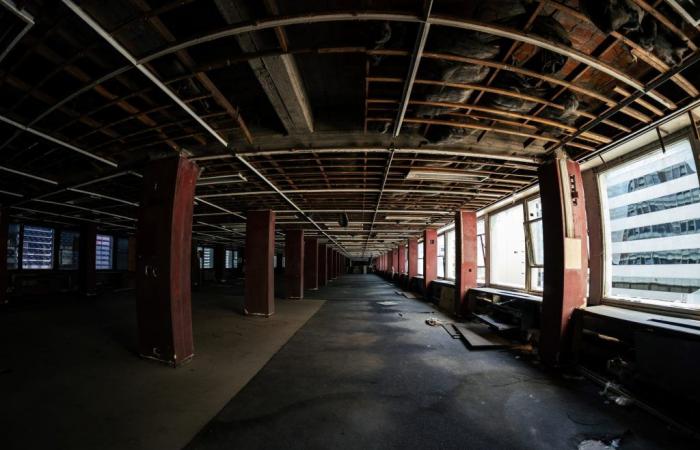Behind the largest and best-located advertising marquee in the City, wait a sleeping giant Its about Silver Building, located on Carlos Pellegrini, diagonally to the Obelisk. Empty and disused urban landmark, it will come to life at least for a few weeks, when it is transformed into host of a new edition of Casa FOA, in October.
It will be the 40th edition of the architecture, design, landscaping and industry exhibition organized by the Jorge Malbran Ophthalmological Foundation to raise funds and allocate them to their charities.
At the moment, it is known that the exhibition will use only two floors, the entrance and the first floor. Architects, landscapers and professionals linked to the industry will have to design living rooms, warehouses, bathrooms, playrooms, cafeterias, kitchens, microcinemas, coworking, etc. “Think, create, design and inhabit” that rectangular box that is ultimately the shape that identifies this building.
The thing is that the Plata Building has a single implementation: sIt is an atypical block of the City, with a front and quiet part of the building – by Carlos Pellegrini and Pasaje Carabelas, respectively – of more than 100 meters long, and sides – by Sarmiento to the north and Perón to the south – of only 35 meters.
The architects Oscar Crivelli and Jorge Heinzmann They made the most of the available meters and designed a building of free plants, when they were quite a novelty. The thing is that originally the project dates back to 1948 and is considered one of the first buildings in modern architecture intended for municipal uses. Work began in 1950 and came to a complete halt in 1954.
The least known façade of the Edificio del Plata, the one that faces the Carabelas passage. Photo House FOA
Then there was a partial inauguration in 1961. But the official opening only came in December 1962. Turns of life: the event was led by architect Alberto Prebisch – a professional also linked to the modern movement – who was mayor and famous author of a fundamental work in the history of the City of Buenos Aires, located meters from the Edificio del Plata: the Obelisk, inaugurated several decades earlier, in 1936.
Why is it also known as Mercado del Plata? Because a food market for this area of the City operated precisely on that block. This old market was vacated and demolished to make way for the construction of the Crivelli and Heinzmann building.
The lower floor of the Plata Building will be intervened for the Casa FOA exhibition, which will be held in October.
Construction of the Plata Building. June 1954. GCBA Archive Photo
In any case, the original project contemplated that the market would continue operating on the ground floor, towards the Carabelas passage, but that never happened; basically because the dynamics in the area had completely changed and the centrality process had already begun. Instead, A headquarters of the Municipal Bank was installed, as the current Banco Ciudad was called in those years.
In 2012, the Buenos Aires Legislature voted the Executive the chance to sell the building, the money from which should be used to purchase a new headquarters of the Buenos Aires Government. This happened four years later, when IRSA took over Del Plata for $68 million. The City then acquired the Norman Foster building in Parque Patricios (originally it was going to be the headquarters of Banco Ciudad).
A challenge for the 40th edition of the exhibition, the transformation of an icon of the City. Photo House FOA
In recent weeks, in a meeting with economic journalists, the head of the company, Eduardo Elsztain, said that it was going to be used for the construction of more than 700 homes.
However, this Tuesday the Buenos Aires government suspended the tax benefits that it was going to grant to this work (and 20 others), for being part of the transformation process of the Microcenter, hit post-pandemic. Sources from the Executive understand that the expenditure that the City was going to make – a compensation in the tax on Gross Income, whose maximum recovery scope can be up to 60% – would hit the public coffers hard.
The Plata Building and a post-apocalyptic postcard. Photo House FOA
From news to news, Del Plata puts its free plants to the test. For many people it will be the opportunity to re-enter – traffic fines were paid there, for example; For others, the chance to meet him and imagine the possible future for this building that needs to work again to improve its urban environment, which is getting a little worse every day.
FOA House
The architecture exhibition hopes to open the doors of the Edificio del Plata by October. This will reach its 40th edition.
The 39th edition intervened in the heritage building of the former Federal Tire. Photo House FOA
The first exhibition took place in 1985, in a petit hotel at 200 Quintana; 35,000 people attended and 950 m2 were intervened. To get an idea of the size it took, you can compare it with last year’s edition: 83,000 people attended and 4,235 m2 were intervened.
Silver Building. The challenge of intervening in space with multiple proposals. Photo House FOA
There was only one year in which it was not done since 1985: 2020, due to the pandemic. In 2022 there were two editions, in Retiro and in the city of Córdoba. Just like in 1989, when two exhibitions were held: in a mansion in Barrio Parque and in the lofts of Darwin, where almost 100,000 people attended.
Through this proposal to disseminate architecture, design and art, the foundation supports ophthalmological research activities and solidarity campaigns.






